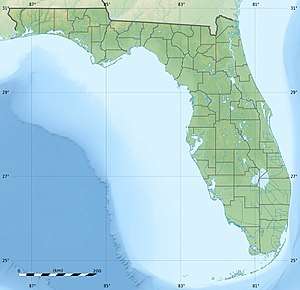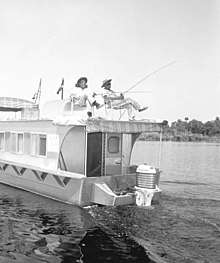Orange Lake (Florida)
Orange Lake is in Alachua County, Florida, about 10 miles (16 km) south of Hawthorne. It has an area of about 12,550 acres (5,080 ha), and is part of the Orange Creek Basin, which is in turn part of the Oklawaha River watershed. Cross Creek flows into it from Lochloosa Lake, and Orange Creek drains it into the Rodman Reservoir. Orange Lake also receives water from Newnans Lake that has been diverted from its historic destination of Paynes Prairie. Orange Lake is noted for fishing, especially bass, with many fishing camps on its shores. The lake also has many natural floating islands, which have an "unusually high diversity", especially of amphibians.[1][2]
| Orange Lake | |
|---|---|
 Orange Lake | |
| Location | Alachua County, Florida |
| Coordinates | 29°27′54″N 82°10′39″W |
| Type | lake |
| Surface area | 12,550 acres (5,080 ha) |

The Timucua village of Potano was located along the western shore of Orange Lake in 1539, when it was visited by the Hernando de Soto expedition. The town of Potano was moved to a site northwest of present-day Gainesville, Florida in 1584 after being burned by the Spanish. The Spanish Mission of San Buenaventura de Potano was established at the old site of the town in 1605 or 1606.[3][4] Remains of the town and the foundation of the mission church were found in 2012, along with artifacts of the de Soto expedition.[5]
The lake was named for its location in a citrus-growing district.[6]
References
- St. Johns River Water Management District - Orange Creek Basin
- Florida Fish and Wildlife Conservation Commission - Orange Lake
- Hann, John H. (1996). A History of the Timucua Indians and Missions. Gainesville, Florida: University Press of Florida. p. 166. ISBN 0-8130-1424-7.
- Milanich, Jerald T. (1995). Florida Indians and the Invasion of Europe. Gainesville, Florida: University Press of Florida. pp. 175, 179–183. ISBN 0-8130-1636-3.
- "The Discovery of Conquistador Hernando De Soto’s 1539 Encampment". Fred White. Presented at College of Central Florida, New World Archaeology Series, Ocala, FL. 2012 ( tDAR id: 391661)
- Ratliff, Freida (Jul 31, 1986). "Citrus is gone, but memories remain". Ocala Star-Banner. pp. 1B. Retrieved 3 November 2015.